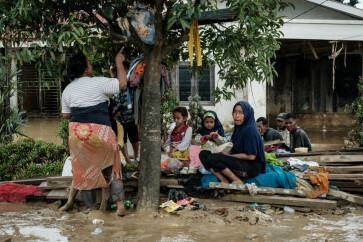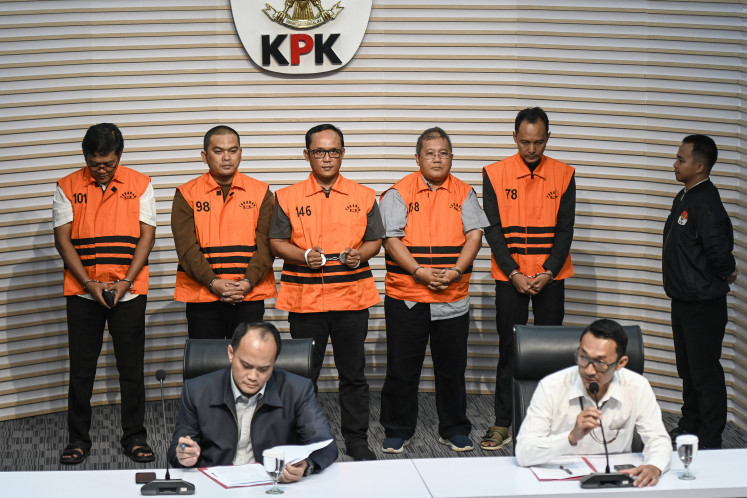Popular Reads
Top Results
Can't find what you're looking for?
View all search resultsPopular Reads
Top Results
Can't find what you're looking for?
View all search resultsBailing out 60 million firms
Our concern is how the government ensures that it will not be trapped into subsidizing unproductive firms and that taxpayer money will reach the targeted beneficiaries all across the country.
Change text size
Gift Premium Articles
to Anyone
 A visitor takes in the batik that was on show at the Beauty of Peranakan Style exhibition at the Tugu Hotel in Malang, East Java, on Wednesday. Micro, small and medium enterprises from Surakarta, Lasem, Pekalongan and Semarang in Central Java as well as Bali and Jakarta took part in the exhibition.
(The Jakarta Post/Aman rochman )
A visitor takes in the batik that was on show at the Beauty of Peranakan Style exhibition at the Tugu Hotel in Malang, East Java, on Wednesday. Micro, small and medium enterprises from Surakarta, Lasem, Pekalongan and Semarang in Central Java as well as Bali and Jakarta took part in the exhibition.
(The Jakarta Post/Aman rochman )
T
he COVID-19 pandemic has caused a double crisis in the economy and public-health system, and the micro, small and medium-scale enterprises (MSME) sector has been one of the hardest-hit of the business world. The damage has been huge as MSMEs are mostly labor-intensive firms spread out across the country.
No wonder, most of the worker layoffs have taken place at MSMEs, as they have thin cash buffers and rely mainly on short-term loans with high interest rates, while their cash flows have virtually stopped. Worse still, most banks have shunned MSMEs amid the current uncertainty, while businesses run on credit.
The Finance Ministry has rightly allocated Rp 35.3 trillion (US$2.43 billion) to bail out an estimated 60 million MSMEs by subsidizing the interest costs and guaranteeing their loans. This stimulus spending is part of the National Economic Recovery program.
Our concern is how the government ensures that it will not be trapped into subsidizing unproductive firms and that taxpayer money will reach the targeted beneficiaries all across the country.
Read also: SMEs switch to producing PPE to survive COVID-19 economic fallout
Finance Minister Sri Mulyani Indrawati seems quite aware of the risk of misallocation and malfeasance given the scale of the distribution of the aid and the government’s notorious reputation in data gathering and management.
The minister’s caution can be seen in the directives she outlined in a recent 45-page decree (PMK65) outlining the screening procedures for MSMEs to access the subsidies. They are quite elaborate involving the Financial Services Authority (OJK), lenders, the government’s Development Finance Comptroller (BPKP) and the big banks selected to disburse the aid. The guidelines provide a multi-layer step in screening the targeted beneficiaries and set up a kind of electronic data interchange system to manage the distribution of the subsidies.
The first line of defense against misallocation and corruption is built in the first layer of screening, which requires that beneficiaries should have taxpayer registration numbers and their loans must still have been current as of February, one month before the pandemic hit Indonesia. This process will help select bona fide MSMEs with good corporate governance.
In the second layer of screening are lenders under the supervision of the OJK that are obliged to verify and assess the commercial viability of the MSME borrowers and provide the validated data on borrowers eligible to get the subsidies into an electronic data interchange system (SIKP). But data on MSMEs that have obtained loans from non-bank lenders outside of OJK oversight, such as cooperatives or microfinance firms, are verified and validated by the BPKP. Fund disbursement by banks assigned by the government to distribute the subsidies are also examined by internal auditors at the Finance Ministry’s inspectorate general.
Read also: Start-ups help SMEs digitalize during pandemic
On paper, the multi-layer oversight, the use of electronic data and online processes to manage the screening and assessment should enhance transparency and facilitate quick disbursement. The system should minimize the risk of misallocation and malfeasance, but that is not enough.
The government must allow public access to at least to the names of the MSME beneficiaries of the taxpayer money in order to ensure a minimum standard of transparency.









